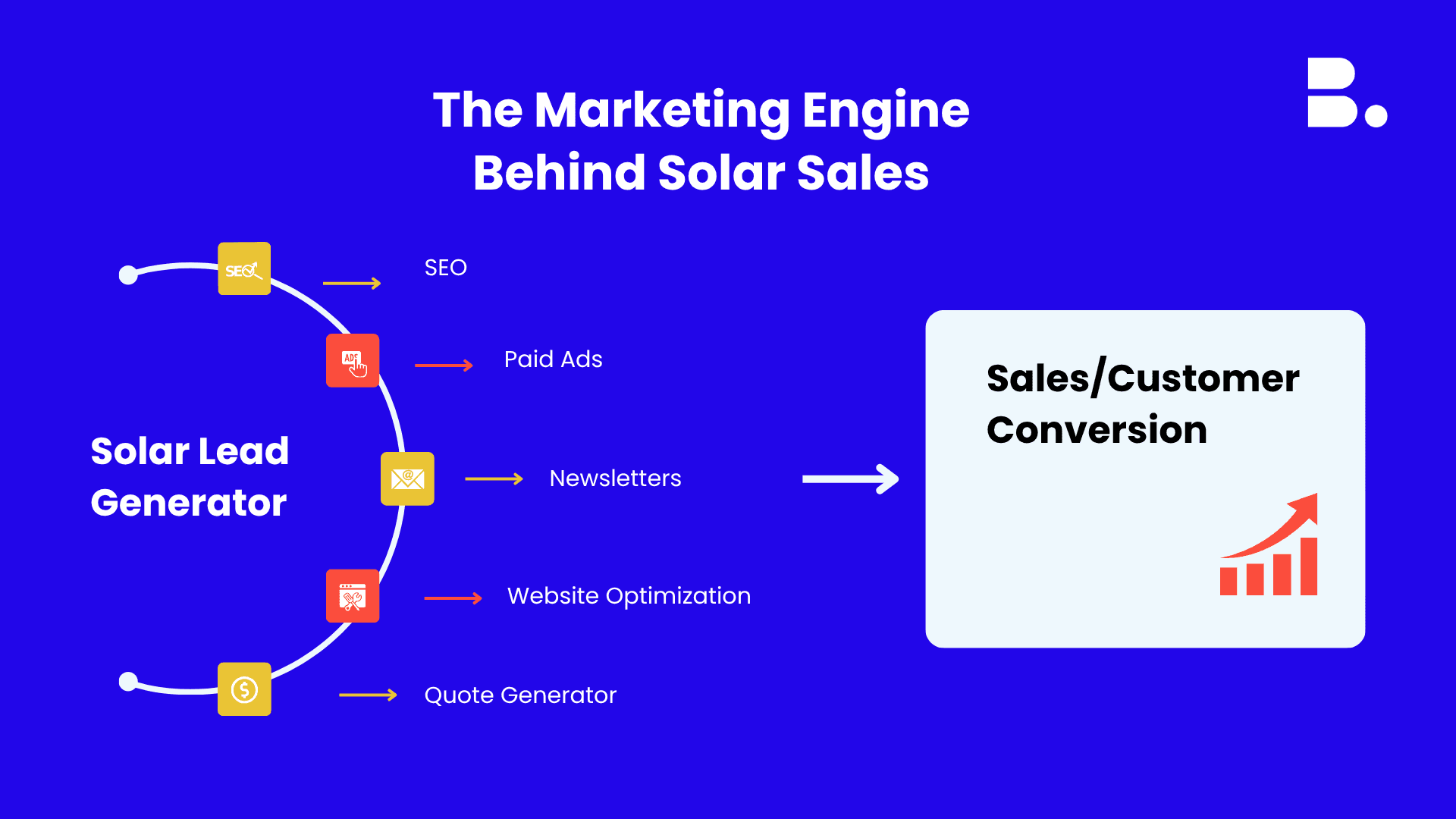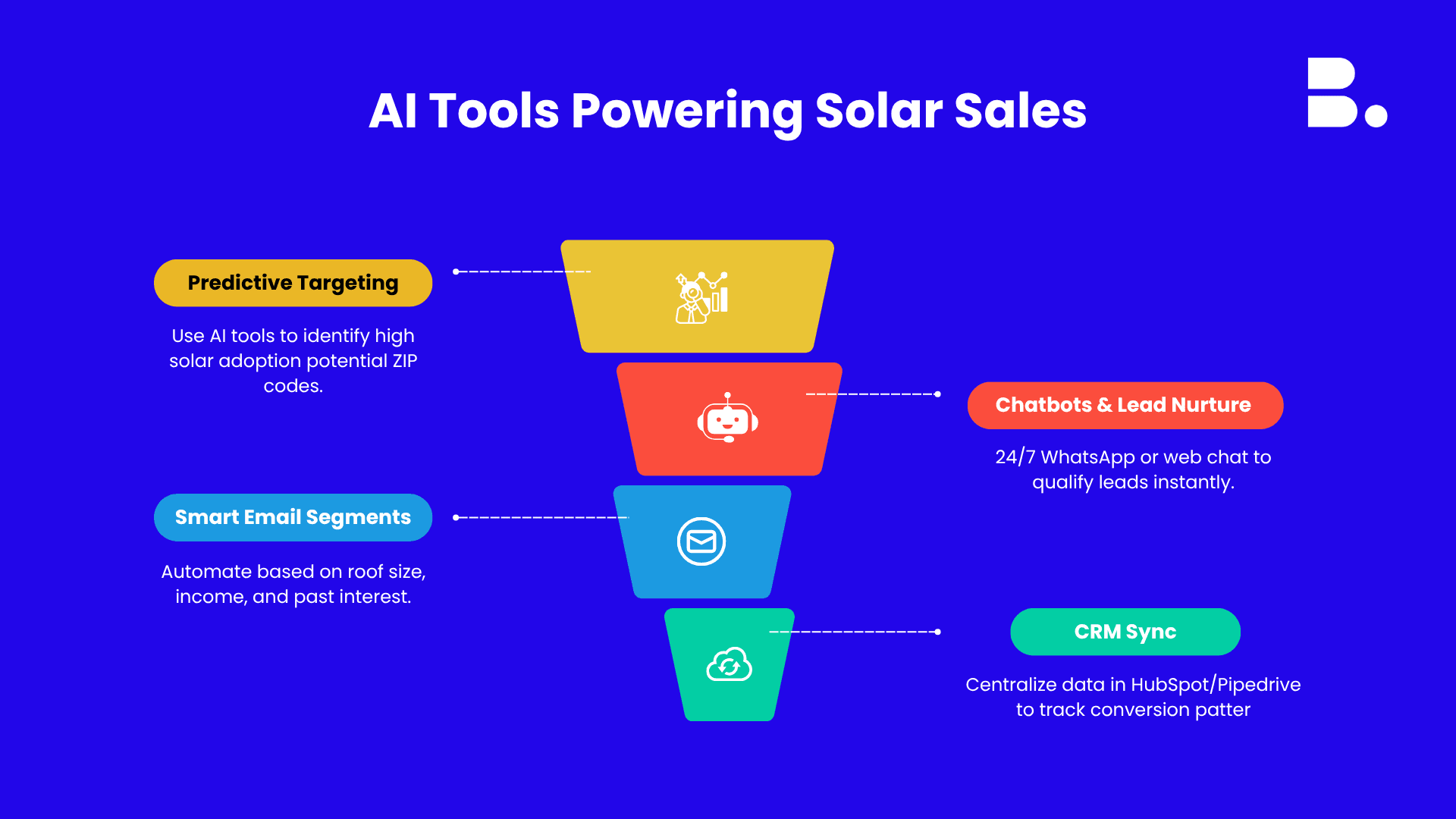Solar Lead Generation in 2025
Posted on
Uncategory
Posted at
Oct 10, 2025
As a founder in the solar industry, you know the landscape has shifted. The days of door-to-door knocking and generic Facebook ads being your primary lead generation engines are over. The market is more competitive, customers are more savvy, and the economic climate is… complicated.
The question isn't if you need a new approach to solar lead generation, but what that approach should be.
The goal is to turn your strategy from a scattered net into a precision-guided missile. In 2025, it's not about reaching the most people; it's about reaching the right people with the right message at the right time.
This blog is your strategic blueprint. We're moving beyond basic tips and diving into the foundational shifts and advanced tactics that will define successful solar companies in the year ahead.
The 2025 Solar Landscape: The Data You Can't Ignore
Before we talk tactics, let's ground ourselves in reality. Understanding the market forces at play is crucial for crafting a message that resonates.
The global solar energy market is projected to reach $373.84 billion by 2029, growing at a CAGR of 6.9% (Fortune Business Insights). The pie is getting bigger, but so is the number of players fighting for a slice.
According to the Solar Energy Industries Association (SEIA), the U.S. solar market installed a record 32.4 GWdc of capacity in 2023. This growth is not uniform; it's concentrated in specific regions and demographics.
The low-hanging fruit is gone. The early adopters who were motivated purely by environmental concerns have largely been captured. The next wave of customers is driven by economic resilience and energy independence. Your messaging must reflect this.
The 2025 Solar Lead Generation Playbook: 5 Foundational Pillars
Forget chasing every possible lead. Your focus must be on building a system that attracts, nurtures, and converts high-intent prospects.
1. Hyper-Local & Hyper-Relevant Content Marketing
Generic blog posts like "The Benefits of Solar" are no longer enough. Your content must answer the specific, pressing questions of homeowners in your exact service areas.
Create "Solar Savings Reports" for specific neighborhoods or zip codes. Use localized data on utility rates (e.g., PG&E, SCE, National Grid) and combine it with satellite imagery tools (like Google Sunroof) to create hyper-personalized content.
Example: Instead of "Solar in California," create a piece titled, "How Roseville Homeowners Are Beating PG&E's Latest Rate Hike with Solar + Battery Storage." This demonstrates immediate, local relevance.
Target long-tail keywords like "solar panel cost [Your City]" or "is solar worth it [Your State] with net metering". This is where your solar lead generation efforts will find qualified searchers.

2. Leverage AI for Predictive Lead Scoring & Personalisation
Artificial intelligence is no longer a buzzword; it's a practical tool for maximizing your sales team's efficiency.
Implement an AI-powered CRM or add-on that scores leads based on predictive data points: roof size (via satellite), household income, local utility provider, age of home, and online behaviour.
Your sales team stops wasting time on "tire-kickers" and prioritizes contacting leads with a 90%+ propensity to convert. Furthermore, use AI to personalize initial outreach emails and ad copy at scale, dynamically inserting the prospect's local utility company or estimated roof square footage.
3. Strategic Partnerships: The Untapped Goldmine
The most trusted advisor for a homeowner considering a major renovation is often not a solar company. it's their local roofer, HVAC specialist, or electrician.
Build a formal referral network with these complementary trades.
Offer them compelling commission structures.
Provide them with training and marketing materials.
Make the handoff process seamless for the customer.
This isn't just a lead source; it's a business development strategy. A strong partnership with a reputable roofer can virtually eliminate one of the biggest objections and friction points in the sales process.
4. Master Social Proof in the Digital Age
Testimonials are good. Verifiable, multi-faceted social proof is better. Go beyond a "Testimonials" page.
Case Studies: Create in-depth PDF case studies showing before/after utility bills, project specifics, and customer interviews.
Video Reviews: A 2-minute video of a happy customer in their home is infinitely more powerful than a 5-star rating.
Third-Party Platforms: Dominate your profiles on Google Business Profile, EnergySage, and the Better Business Bureau (BBB). Encourage happy customers to leave reviews here, as they hold more weight than reviews on your own website.
5. Retargeting with a Value-Driven Funnel
Most visitors to your site won't fill out a form on their first visit. A generic retargeting ad that just shows your logo is a wasted opportunity - Build a sophisticated retargeting funnel.
Awareness: For all website visitors, retarget with an ad for your flagship guide (e.g., "The Homeowner's Guide to Solar Financing in 2025").
Consideration: For those who visited pricing or calculator pages, retarget with ads highlighting your 25-year warranty or premium panel quality.
Decision: For those who visited the contact page but didn't submit, use a direct offer: "Schedule Your Free Consultation This Week and Get a $500 Installations Credit."
Leverage AI: From Hype to Your Hardest-Working Employee
Many founders hear "AI" and think of chatbots or automated emails. While those are applications, the true power of AI in solar lead generation is as a force multiplier for your entire operation.
Think of AI as your most data-literate, hyper-efficient, and scalable employee. Here’s how to put it to work:
a. Hyper-Personalized Prospecting & Targeting:
Forget spraying ads across a broad "homeowner" demographic. AI platforms can analyze vast datasets—including satellite imagery, property records, and utility rate information—to identify the most likely buyers in your territory.
Practical Application: Use an AI tool that scans neighborhoods via satellite imagery to automatically flag homes with large, south-facing roofs in high-utility-rate areas. It can then cross-reference this with property data to filter out homes that are too old or too shaded. The result? Your ad spend is directed only at the top 10% of viable prospects, dramatically improving your ROI.
b. The Conversational AI Assistant (Beyond the Basic Chatbot):
A basic chatbot that says "How can I help you?" is useless. A sophisticated, solar-trained AI assistant can be your 24/7 lead qualification engine.
Practical Application: Implement an AI assistant on your website that can:
Answer complex questions about tax credits, net metering policies, and battery storage.
Use the address a visitor provides to pull up a preliminary satellite image of their roof and give a rough, initial savings estimate in real-time.
Ask qualifying questions about energy bills and homeownership to score the lead before a human ever gets involved.
This not only captures leads but pre-qualifies them intensely, so your sales team only gets warm, informed leads ready for a consultation.
c. AI-Optimized Sales Outreach & Follow-Up:
Timing & personalization play a very significant role. AI can analyze your most successful sales emails and calls to determine what messaging works best for different lead types.
Practical Application: An AI-powered sales enablement tool can:
Auto-generate first drafts of personalized outreach emails for your sales team, pulling in the prospect's address, estimated roof size, and local utility company.
Analyze call transcripts in real-time to flag when a sales rep misses a key objection or fails to explain a crucial benefit, allowing for immediate coaching.
Predict the optimal time to call or email a specific lead based on their online activity, drastically increasing connection rates.
AI won't replace salespeople, but salespeople who use AI will replace those who don't. The key is to leverage AI to handle the data and the mu ane, freeing up your human team to do what they do best: build trust and close deals.
By integrating AI at these strategic points, you move from reactive lead chasing to proactive, intelligent solar lead generation. You're not just working harder; you're working smarter, with a system that learns and improves over time.

Move with Time
"Marketing is no longer about the stuff that you make, but about the stories you tell." – Seth Godin.
In 2025, your solar lead generation strategy is the story you tell to a market that is listening more closely than ever. They aren't just buying panels; they are buying energy security, financial predictability, and a stake in the future.
As a founder, your role is to stop thinking in terms of single tactics and start building a cohesive, data-driven system. Integrate your hyper-local content, powered by AI insights, supported by strategic partners, and validated by undeniable social proof. This is how you build a solar company that doesn't just survive in 2025, but thrives.
Your Solar Lead Generation Questions, Answered
Q1: How to generate leads for solar sales in 2025?
The most effective strategy for 2025 is to combine digital marketing with traditional methods. This means you should leverage content marketing (SEO blogs, videos), social media (organic posts, targeted ads), and paid search ads (Google Ads) to attract prospects online.
However, this must be supported by hyper-local strategies like forming partnerships with local contractors (roofers, electricians) and leveraging verifiable social proof (case studies, video testimonials) to build the trust needed to close deals in a competitive market. The key is a data-driven, multi-channel approach.
Q2: How to generate leads for solar sales?
Solar lead generation requires a diversified portfolio of tactics. Foundational strategies include:
Digital Presence: A strong website optimized for local SEO and conversion.
Content Marketing: Creating valuable blogs, guides, and videos that answer homeowner questions.
Paid Advertising: Using Google Ads and social media ads to target high-intent audiences.
Referral Programs: Incentivizing happy customers to refer friends and family.
Strategic Partnerships: Building formal relationships with complementary home service businesses.
There is no single "best" method; the most successful companies consistently execute across several of these channels.
Q3: How to generate solar leads on Facebook?
Generating quality solar leads on Facebook requires a strategic approach. First, define your target audience precisely using Facebook's detailed targeting options, such as homeowners aged 30-65 in specific zip codes with high property values.
Next, create compelling ad creatives with clear calls-to-action (CTAs) and social proof, such as short video testimonials or infographics showing dollar savings. Finally, use Facebook's lead generation ads or direct people to a dedicated landing page to capture contact information seamlessly without leaving the platform.
Q4: How to generate your own solar leads?
You can generate your own solar leads through a combination of digital marketing, partnerships, and traditional methods. This is often more cost-effective and builds a stronger, more authentic brand in the long run. Key methods include:
Building a content hub on your website to establish authority and attract organic search traffic.
Running hyper-local Google Ads campaigns targeting "solar installer near me" type keywords.
Developing a formal referral network with local roofers and electricians.
Implementing a customer referral program to turn your existing clients into a lead source.
This approach reduces reliance on expensive third-party lead brokers and gives you full control over the customer journey.
Q5: How to generate solar leads online?
To generate solar leads online effectively, you need a multi-pronged digital strategy. You should use content marketing to create SEO-optimised blogs and videos, leverage paid ads on platforms like Google and Facebook, and engage with potential customers on social media to build a community.
Furthermore, it's crucial to build an email list to nurture leads over time with valuable information and offers, and encourage customer referrals through online review systems and digital referral incentives. This creates a full-funnel online ecosystem that attracts, engages, and converts prospects.
More useful reads





